check engine light SUZUKI JIMNY 2022 Owner's Manual
[x] Cancel search | Manufacturer: SUZUKI, Model Year: 2022, Model line: JIMNY, Model: SUZUKI JIMNY 2022Pages: 421, PDF Size: 6.35 MB
Page 331 of 421
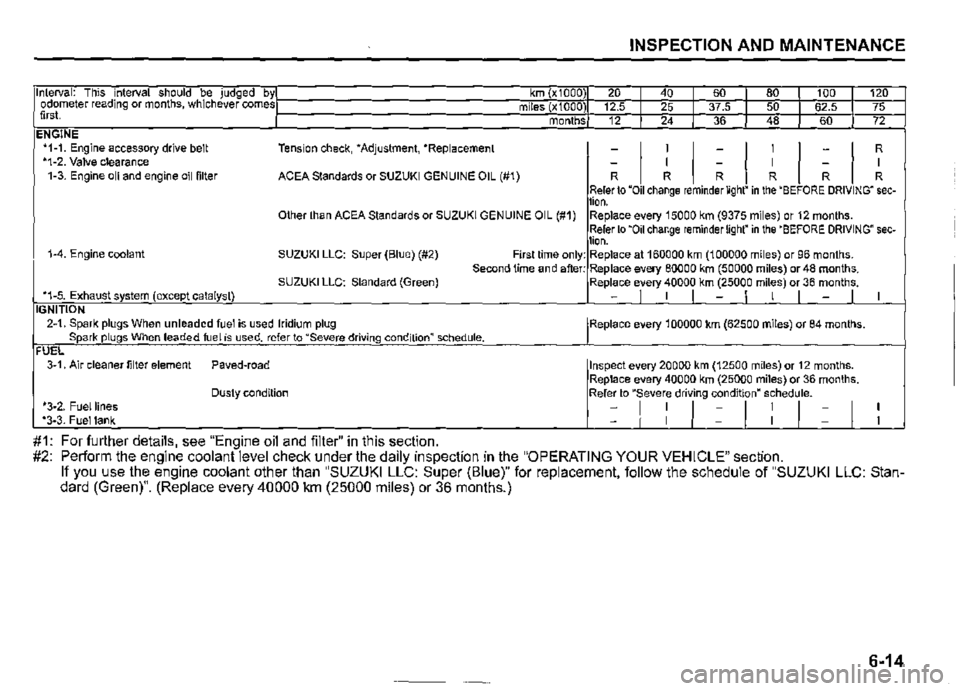
INSPECTION AND MAINTENANCE
Interval: This interval should be judged byl km (x1000) 20 I 40 I 60 I 80 I 100 I 120 odometer reading or months, whichever comesI mi!es (x1000) 12.5 I 25 I 37.5 I 50 I 62.5 I 75 first. I months/ 12 I 24 I 36 I 48 I 60 I 72 ENGINE •1-1. Engine accessory drive belt Tension check, *Adjustment, *Replacement -
I
I
I
-
I
I
I
-
I
R *1-2. Valve clearance -I -I -I 1-3. Engine oil and engine oil filter ACEA Standards or SUZUKI GENUINE OIL (#1) R R R R R R Refer to "Oil change reminder light" in the "BEFORE DRIVING" sec-lion. Other than ACEA Standards or SUZUKI GENUINE OIL (#1) Replace every 15000 km (9375 miles) or 12 months. Refer to "Oil change reminder light" in the "BEFORE DRIVING" sec-lion. 1-4. Engine coolant SUZUKI LLC: Super (Blue) (#2) First time only: Replace at 160000 km (100000 miles) or 96 months. Second time and after: Replace every 80000 km (50000 miles) or 48 months. SUZUKI LLC: Standard (Green) Replace every 40000 km (25000 miles) or 36 months. *1-5. Exhaust system (except catalyst) -I I I -I I I -I I IGNITION 2-1. Spark plugs When unleaded fuel is used Iridium plug !Replace every 100000 km (62500 miles) or 84 months. Spark plugs When leaded fuel is used, refer to "Severe driving conditiontt schedule. FUEL 3-1. Air cleaner filter element Paved-road Inspect every 20000 km (12500 miles) or 12 months. Replace every 40000 km (25000 miles) or 36 months. Dusty condition Refer to "Severe driving condition" schedule.
I *3-2. Fuel lines
= I : I = I : I
-I *3-3. Fuel tank -I
#1: For further details, see "Engine oil and filter" in this section. #2: Perform the engine coolant level check under the daily inspection in the "OPERATING YOUR VEHICLE" section. If you use the engine coolant other than "SUZUKI LLC: Super (Blue)" for replacement, follow the schedule of "SUZUKI LLC: Standard (Green)". (Replace every 40000 km (25000 miles) or 36 months.)
6-14
Page 332 of 421
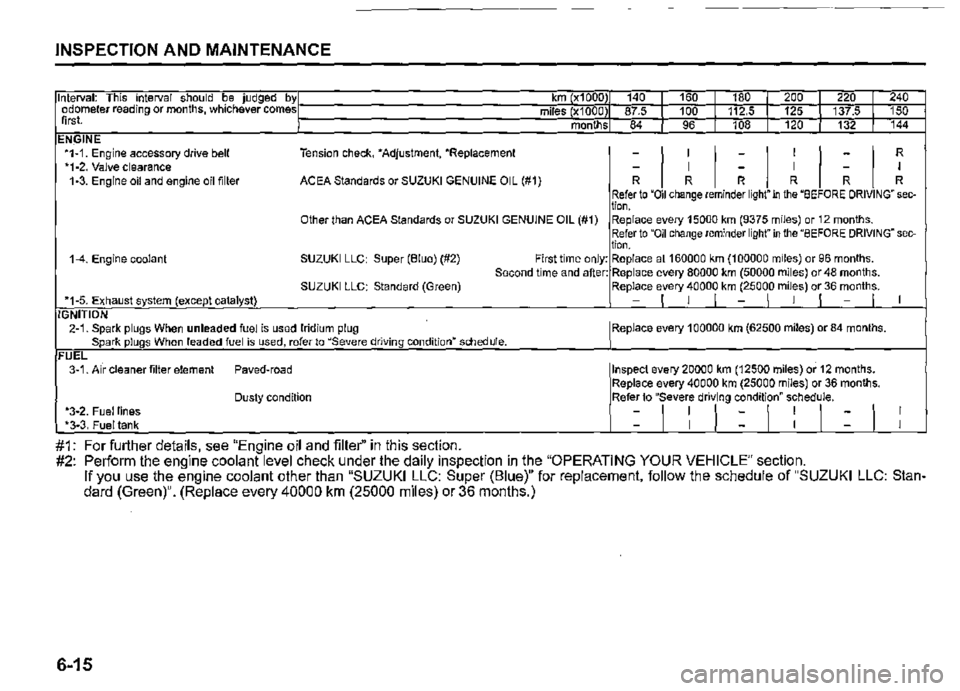
INSPECTION AND MAINTENANCE
Interval: This interval should be judged byl km (x1000)I 140 I 160 I 180 I 200 I 220 I 240 odometer reading or months, whichever comesI miles (x1000)I 87.5 I 100 I 112.5 I 125 I 137.5 ! 150 first. 1 monthsI 84 I 96 I 108 I 120 I 132 I 144 ENGINE •1-1. Engine accessory drive belt Tension check, *Adjustment, *Replacement -
I
I
I
-
I
I
I
-
I
R *1-2. Valve clearance -I -I -I 1-3. Engine oil and engine oil filter ACEA Standards or SUZUKI GENUINE OIL (#1) R R R R R R Refer to "Oil change reminder light" in the "BEFORE DRIVING" sec-lion. Other than ACEA Standards or SUZUKI GENUINE OIL (#1) Replace every 15000 km (9375 miles) or 12 months. Refer to "Oil change reminder light" in the "BEFORE DRIVING" sec-lion. 1-4. Engine coolant SUZUKI LLC: Super (Blue) (#2) First time only: Replace at 160000 km (100000 miles) or 96 months. Second time and after: Replace every 80000 km (50000 miles) or 48 months. SUZUKI LLC: Standard (Green) Replace every 40000 km (25000 miles) or 36 months. *1-5. Exhaust system (except catalyst) -I I I -I I I -I I IGNITION 2-1. Spark plugs When unleaded fuel is used Iridium plug !Replace every 100000 km (62500 miles) or 84 months. Spark plugs When leaded fuel is used, refer to ~severe driving condition~ schedule. FUEL 3-1. Air cleaner filter element Paved-road Inspect every 20000 km (12500 miles) or 12 months. Replace every 40000 km (25000 miles) or 36 months. Dusty condition Refer to "Severe driving condition~ schedule. *3-2. Fuel lines
= I : I = I : I -I I *3-3. Fuel tank -I
#1: For further details, see "Engine oil and filter" in this section. #2: Perform the engine coolant level check under the daily inspection in the "OPERATING YOUR VEHICLE" section. If you use the engine coolant other than "SUZUKI LLC: Super (Blue)" for replacement, follow the schedule of "SUZUKI LLC: Standard (Green)". (Replace every 40000 km (25000 miles) or 36 months.)
6-15
Page 336 of 421
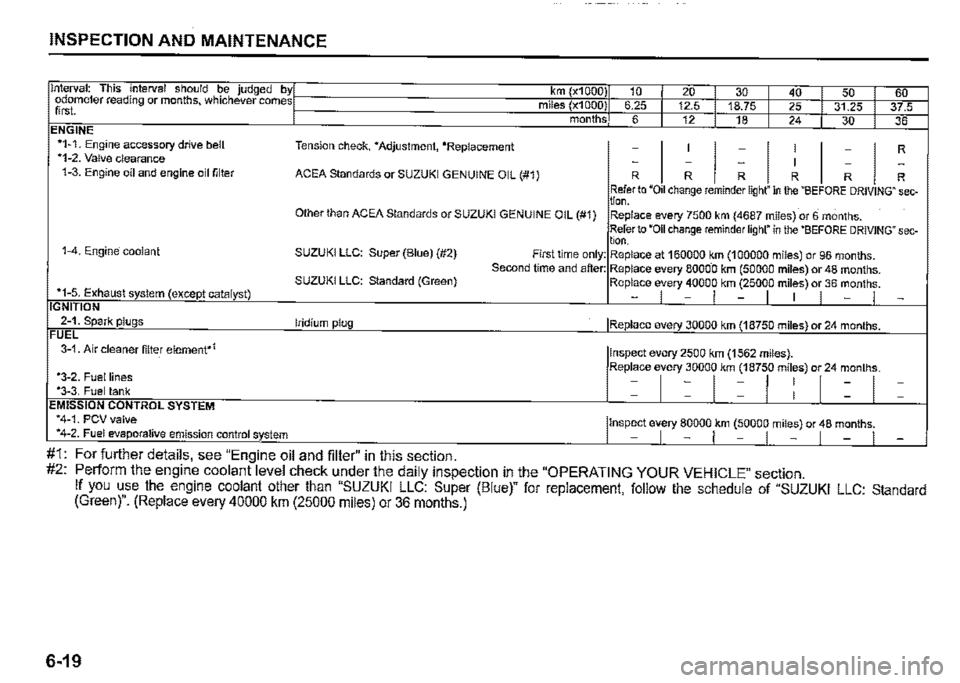
INSPECTION AND MAINTENANCE
Interval: This interval should be judged byl km (x1000)I 10 I 20 I 30 I 40 I 50 I 60 odometer reading or months, whichever comesI miles (x1000)I 6.25 I 12.5 I 18.75 I 25 I 31.25 I 37.5 ft~ I months! 6 I 12 I 18 I 24 I 30 I 36 ENGINE *1-1. Engine accessory drive belt Tension check, *Adjustment, *Replacement -
I
I
I
-
I
I
I
-
I
R *1-2. Valve clearance ---I --1-3. Engine oil and engine oil filter ACEA Standards or SUZUKI GENUINE OIL (#1) R R R R R R Refer to "Oil change reminder light" In the "BEFORE DRIVING" sec-Uon. Other than ACEA Standards or SUZUKI GENUINE OIL (#1) Replace every 7500 km (4687 miles) or 6 months. Refer to "011 change reminder light" in the "BEFORE DRIVING" sec-tion. 1-4. Engine· coolant SUZUKI LLC: Super (Blue) (#2) First time only: Replace at 160000 km (100000 miles) or 96 months. Second time and after: Replace every 80000 km (50000 miles) or 48 months. SUZUKI LLC: Standard (Green) Replace every 40000 km (25000 miles) or 36 months. *1-5. Exhaust system (except catalyst) -I -I -I I I -I -IGNITION 2-1. Spark plugs Iridium plug !Replace every 30000 km (18750 miles) or 24 months. FUEL 3-1. Air cleaner filter element"1 Inspect every 2500 km (1562 miles). Replace every 30000 km (18750 miles) ol 24 months. *3-2. Fuel lines -I -I -I I -I -*3-3. Fuel tank ---I --EMISSION CONTROL SYSTEM *4-1. PCV valve !Inspect every 80000 km (50000 miles) or fB monthsi *4-2. Fuel evaporative emission control system -1-1-1---#1: For further details, see "Engine oil and filter" in this section.
#2: Perform the engine coolant level check under the daily inspection in the "OPERATING YOUR VEHICLE" section. If you use the engine coolant other than "SUZUKI LLC: Super (Blue)" for replacement, follow the schedule of "SUZUKI LLC: Standard (Green)". (Replace every 40000 km (25000 miles) or 36 months.)
6-19
Page 337 of 421
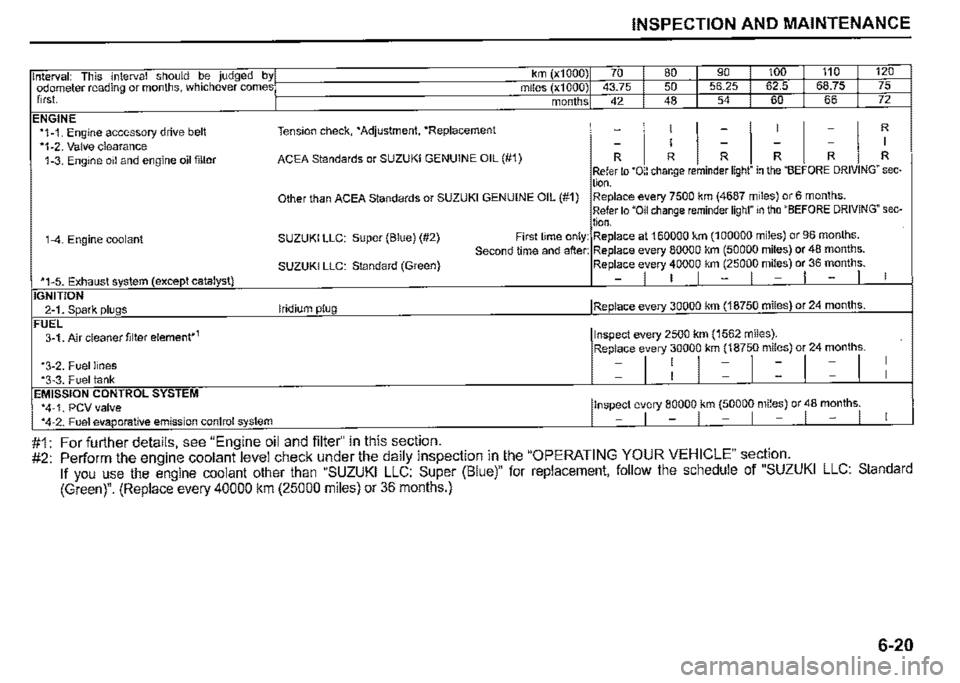
INSPECTION AND MAINTENANCE
Interval: This interval should be judged byl km (x1000) 70 I 80 I 90 I 100 I 110 I 120 odometer reading or months, whichever comesi miles (x1000) 43.75 I 50 I 56.25 I 62.5 I 68.75 I 75 first. I months 42 I 48 I 54 I 60 I 66 I 72
ENGINE *1-1. Engine accessory drive bell Tension check, *Adjustment, *Replacement -
I
I
I
-
I
I
I
-
I
R
*1-2. Valve clearance -I ---I
1-3. Engine oil and engine oil filter ACEA Standards or SUZUKI GENUINE OIL (#1) R R R R R R Refer to "Oil change reminder light" in the "BEFORE DRIVING" sec-tion. Other than ACEA Standards or SUZUKI GENUINE OIL (#1) Replace every 7500 km (4687 miles) or 6 months. Refer to "Oil change reminder light" in the "BEFORE DRIVING" sec-lion.
1-4. Engine coolant SUZUKI LLC: Super (Blue) (#2) First time only: Replace at 160000 km (100000 miles) or96 months. Second time and after: Replace every 80000 km (50000 miles) or 48 months.
SUZUKI LLC: Standard (Green) Replace erery 4000~ km (250010 miles) 0136 months.
*1-5. Exhaust system (except catalyst) -I ---I I
IGNITION 2-1. Spark plugs Iridium plug !Replace every 30000 km (18750 miles) or 24 months.
FUEL 3-1. Air cleaner filter element*1 Inspect every 2500 km (1562 miles). Replace every 30000 km (18750 miles) or 24 months.
*3-2. Fuel lines = I : I = I = I = I
I
*3-3. Fuel tank I
EMISSION CONTROL SYSTEM *4-1. PCV valve *4-2. Fuel evaporative emission control system
!Inspect every 80000 km (50000 miles) or 48 months. I -I I I -I I
#1: For further details, see "Engine oil and filter" in this section. #2: Perform the engine coolant level check under the daily inspection in the "OPERATING YOUR VEHICLE" section. If you use the engine coolant other than "SUZUKI LLC: Super (Blue)" for replacement, follow the schedule of "SUZUKI LLC: Standard
(Green)". (Replace every 40000 km (25000 miles) or 36 months.)
6-20
Page 351 of 421
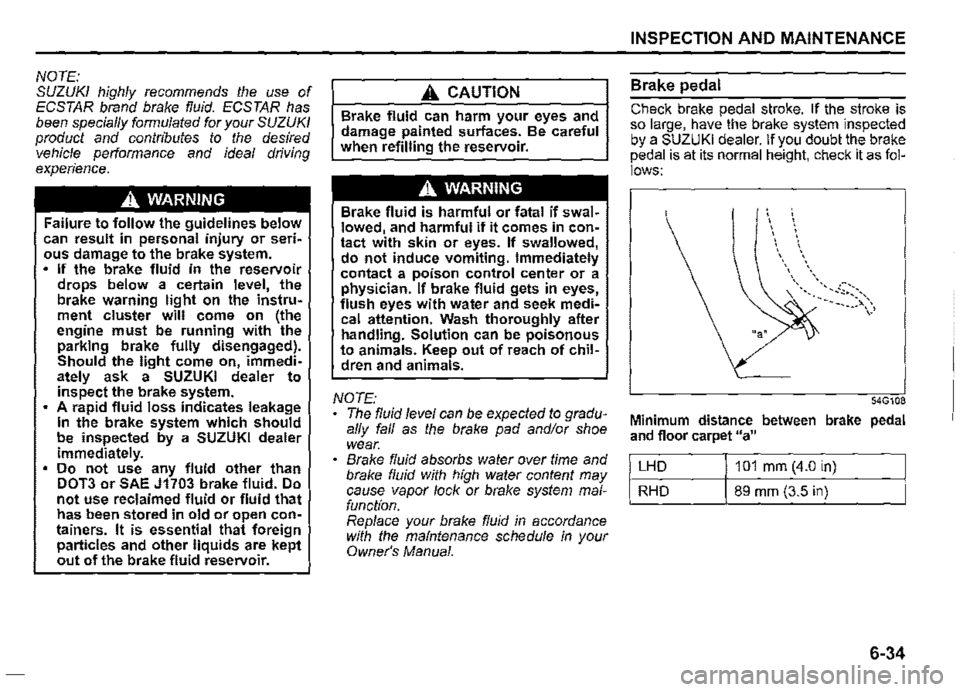
NOTE: SUZUKI highly recommends the use of ECSTAR brend brake fluid. ECSTAR has been specially formulated for your SUZUKI product and contributes to the desired vehicle performance and ideal driving experience.
A WARNING
Failure to follow the guidelines below can result in personal injury or serious damage to the brake system. . If the brake fluid in the reservoir drops below a certain level, the brake warning light on the instrument cluster will come on (the engine must be running with the parking brake fully dise~gaged). Should the light come on, 1mmed1-ately ask a SUZUKI dealer to inspect the brake system. A rapid fluid loss indicates leakage in the brake system which should be inspected by a SUZUKI dealer immediately. Do not use any fluid other than DOT3 or SAE J1703 brake fluid. Do not use reclaimed fluid or fluid that has been stored in old or open containers. It is essential that foreign particles and other liquids are kept out of the brake fluid reservoir.
A CAUTION
Brake fluid can harm your eyes and damage painted surfaces. Be careful when refilling the reservoir.
A WARNING
Brake fluid is harmful or fatal if swallowed, and harmful if it comes in contact with skin or eyes. If swallowed, do not induce vomiting. Immediately contact a poison control center or a physician. If brake fluid gets in eye~, flush eyes with water and seek medical attention. Wash thoroughly after handling. Solution can be poisonous to animals. Keep out of reach of children and animals.
NOTE: • The fluid /eve/ can be expected to gredually fall as the brake pad and/or shoe wear. Brake fluid absorbs water over time and brake fluid with high water content may cause vapor lock or breke system malfunction. Replace your breke fluid in accordance with the maintenance schedule m your Owner's Manual.
INSPECTION AND MAINTENANCE
Brake pedal
Check brake pedal stroke. If the stroke is so large, have the brake system inspected by a SUZUKI dealer. If you doubt th_e brake pedal is at its normal height, check 1t as follows:
54G108
Minimum distance between brake pedal and floor carpet "a"
LHD 101 mm (4.0 in)
RHD 89 mm (3.5 in)
6-34
Page 361 of 421
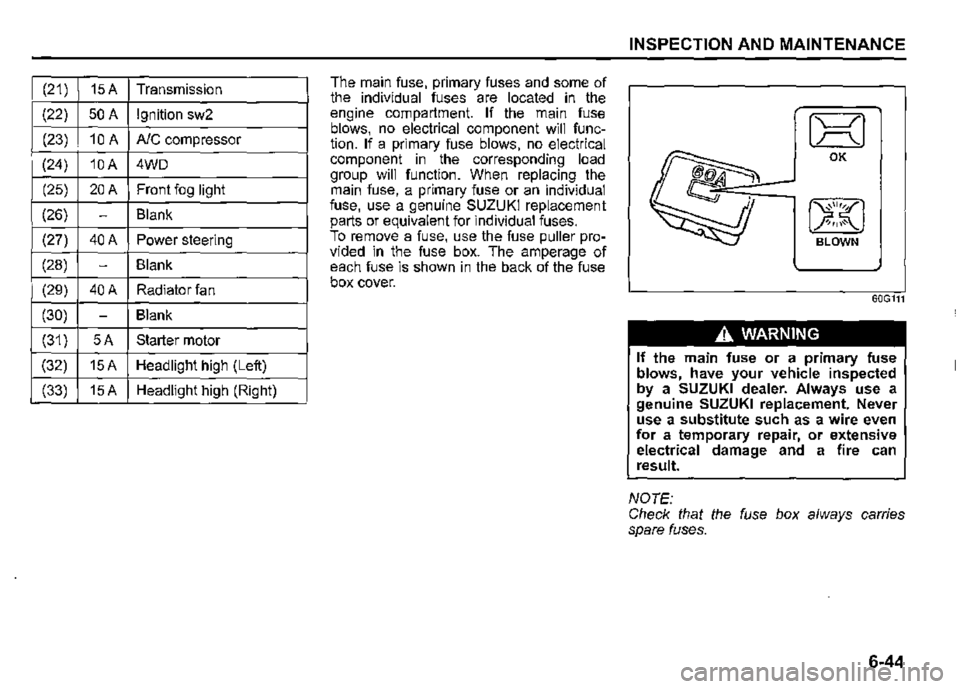
(21) 15A Transmission
(22) 50A Ignition sw2
(23) 10 A A/C compressor
(24) 10A 4WD
(25) 20A Front fog light
(26) -Blank
(27) 40A Power steering
(28) -Blank
(29) 40A Radiator fan
(30) -Blank
(31) 5A Starter motor
(32) 15A Headlight high (Left)
(33) 15A Headlight high (Right)
The main fuse, primary fuses and some of the individual fuses are located in the engine compartment. If the main fuse blows, no electrical component will function. If a primary fuse blows, no electrical component in the corresponding load group will function. When replacing the main fuse, a primary fuse or an individual fuse, use a genuine SUZUKI replacement parts or equivalent for individual fuses. To remove a fuse, use the fuse puller provided in the fuse box. The amperage of each fuse is shown in the back of the fuse box cover.
INSPECTION AND MAINTENANCE
IX! OK
BLOWN
60G111
A. WARNING
If the main fuse or a primary fuse blows, have your vehicle inspected by a SUZUKI dealer. Always use a genuine SUZUKI replacement. Never use a substitute such as a wire even for a temporary repair, or extensive electrical damage and a fire can result.
NOTE: Check that the fuse box always carries spare fuses.
6-44
Page 387 of 421
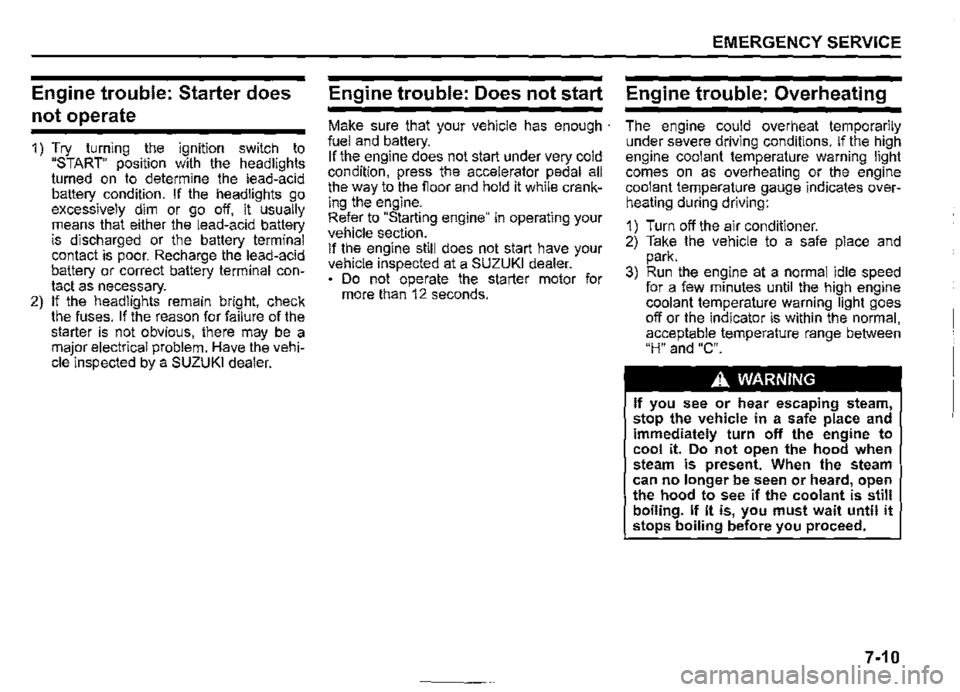
Engine trouble: Starter does
not operate
1) Try turning the ignition switch to "START" position with the headlights turned on to determine the lead-acid battery condition. If the headlights go excessively dim or go off, it usually means that either the lead-acid battery is discharged or the battery terminal contact is poor. Recharge the lead-acid battery or correct battery terminal contact as necessary. 2) If the headlights remain bright, check the fuses. If the reason for failure of the starter is not obvious, there may be a major electrical problem. Have the vehicle inspected by a SUZUKI dealer.
Engine trouble: Does not start
Make sure that your vehicle has enough · fuel and battery. If the engine does not start under very cold condition, press the accelerator pedal all the way to the fioor and hold it while cranking the engine. Refer to "Starting engine" in operating your vehicle section. If the engine still does not start have your vehicle inspected at a SUZUKI dealer. Do not operate the starter motor for more than 12 seconds.
EMERGENCY SERVICE
Engine trouble: Overheating
The engine could overheat temporarily under severe driving conditions. If the high engine coolant temperature warning light comes on as overheating or the engine coolant temperature gauge indicates overheating during driving:
1) Turn off the air conditioner. 2) Take the vehicle to a safe place and park. 3) Run the engine at a normal idle speed for a few minutes until the high engine coolant temperature warning light goes off or the indicator is within the normal, acceptable temperature range between "H" and "C".
A WARNING
If you see or hear escaping steam, stop the vehicle in a safe place and immediately turn off the engine to cool it. Do not open the hood when steam is present. When the steam can no longer be seen or heard, open the hood to see if the coolant is still boiling. If it is, you must wait until it stops boiling before you proceed.
7-10
Page 388 of 421
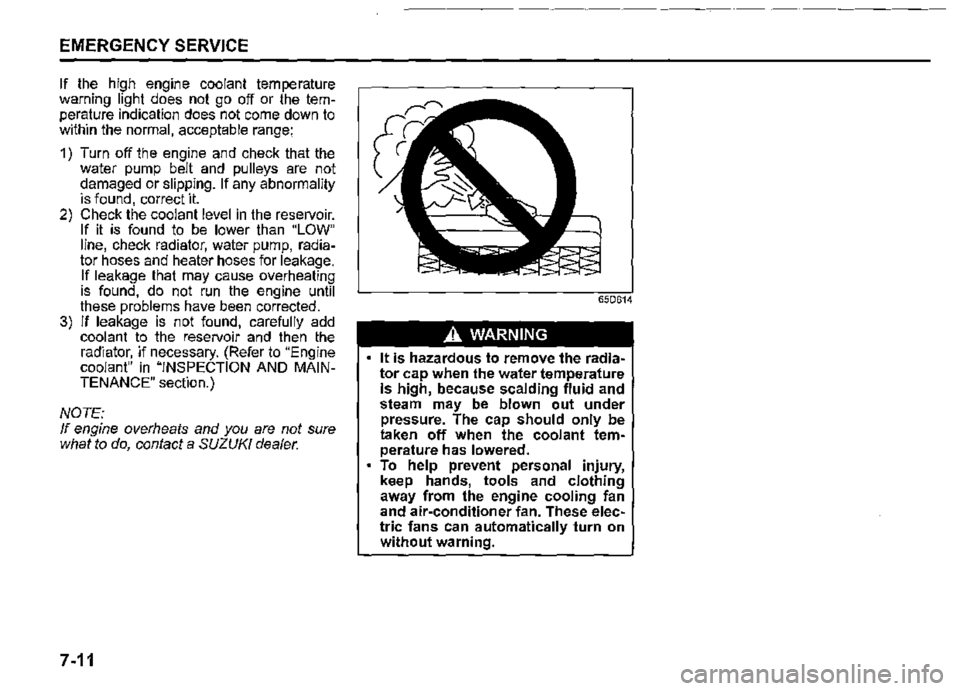
EMERGENCY SERVICE
If the high engine coolant temperature warning light does not go off or the temperature indication does not come down to within the normal, acceptable range:
1) Turn off the engine and check that the water pump belt and pulleys are not damaged or slipping. If any abnormality is found, correct it. 2) Check the coolant level in the reservoir. If it is found to be lower than "LOW" line, check radiator, water pump, radiator hoses and heater hoses for leakage. If leakage that may cause overheating is found, do not run the engine until these problems have been corrected. 3) If leakage is not found, carefully add coolant to the reservoir and then the radiator, if necessary. (Refer to "Engine coolant" in "INSPECTION AND MAINTENANCE" section.)
NOTE: If engine overheats and you are not sure what to do, contact a SUZUKI dealer.
7-11
650614
A WARNING
• It is hazardous to remove the radiator cap when the water temperature is high, because scalding fluid and steam may be blown out under pressure. The cap should only be taken off when the coolant temperature has lowered. To help prevent personal injury, keep hands, tools and clothing away from the engine cooling fan and air-conditioner fan. These electric fans can automatically turn on without warning.
Page 394 of 421

APPEARANCE CARE
Washing by hand
,r l'J J,
r,
60B212S
When washing the vehicle, park it in the place where direct sunlight does not fall on it as much as possible and follow the instructions below: 1) Flush the underside of body and wheel housings with pressurized water to remove mud and debris. Use plenty of water.
NOTICE
When washing the vehicle: • Avoid directing steam or hot water of more than 80°C (176°F) on plastic parts. To avoid damaging engine components, do not use pressurized water in the engine compartment.
8-5
2) Rinse the body to loosen the dirt. Remove dirt and mud from the body exterior with running water. You may use a soft sponge or brush. Do not use hard materials which can scratch the . paint or plastic. Remember that the headlight covers or lenses are made of plastic in many cases.
NOTICE
To avoid damage to the paint or plastic surface, do not wipe the dirt off without ample water. Follow the above procedure.
3) Wash the entire exterior with a mild detergent or car wash soap using a sponge or soft cloth. The sponge or cloth should be frequently soaked in the soap solution.
NOTICE
When using a commercial car wash product, observe the cautions specified by the manufacturer. Never use strong household detergents or soaps.
4) Once the dirt has been completely removed, rinse off the detergent with running water. 5) Wipe off the vehicle body with a wet chamois or cloth and allow it to dry in the shade.
6) Check carefully for damage to painted surfaces. If there is any damage, touch up the damage following the procedure below: 1. Clean all damaged spots and allow them to dry. 2. Stir the paint and touch up the damaged spots lightly using a small brush. 3. Allow the paint to dry completely.
Washing by an automatic car wash
NOTICE
If you use an automatic car wash, check that your vehicle's body parts, such as spoilers, cannot be damaged. If you are in doubt, consult the car wash operator for advice.
Page 411 of 421

INDEX
INDEX Brake system warning light ................................................ 2-41
Brakes ................................................................................... 6-33 Symbols Braking .................................................................................. 3-53 "SOS" button ..................................................................... 10-12 Brightness control ...................................................... 2-17. 2-26
A Built date ............................................................................... 10-1
Accelerator pedal ................................................................... 3-7 Bulb replacement ................................................................. 6-47
Accessory socket .................................................................. 5-6 C Adding coolant. .................................................................... 6-29 Catalytic converter ................................................................. 4-9 Adjusting headlight pattern ................................................ 2-60 Central door locking system ................................................. 2-3
Air cleaner ............................................................................ 6-30 Changing engine oil and filter ............................................. 6-26 Air conditioning system ...................................................... 6-58 Changing wheels .................................................................... 7-4 AIRBAG light ............................................................... 1-36. 2-45 Charging light ....................................................................... 2-44
Anti-lock brake system (ABS) ................................... 3-54. 3-56 Chassis serial number ........................................................... 9-1 Anti-lock brake system (ABS) warning light.. ................... 2-42 Child restraint ....................................................................... 10-1 Anti-theft feature .................................................................. 5-76 Child restraint system for countries applied Assist grips ............................................................................ 5-8 for UN Regulation No.16 ............................................. 1-20. 10-7 Automatic headlight leveling system warning light.. ....... 2-50 Child restraint systems ....................................................... 1-18
Automatic heating and air conditioning system Clock ............................................................................ 2-19. 2-29 (climate control) ................................................................... 5-23 Clutch pedal ................................................................... 3-7. 6-33 Automatic light operation ................................................... 2-56 Coolant level check .............................................................. 6-29 Automatic transmission ...................................................... 3-1 O Coolant replacement... ......................................................... 6-29 Average fuel consumption ......................................... 2-20. 2-30 Corrosion prevention ............................................................. 8-1 Average speed ..................................................................... 2-30 Cup holder ............................................................................ 5-11
8 Cup holder and storage area .............................................. 5-1 O
Battery .................................................................................. 6-41 D
Battery replacement .............................................................. 2-7
Bluetooth® audio ................................................................. 5-71
Bluetooth® hands-free ......................................................... 5-62
Daily inspection check list ..................................................... 3-1
Daytime running light .......................................................... 6-50
Daytime running light (D.R.L.) system ............................... 2-58 Brake assist system ............................................................ 3-53 Door locks ............................................................................... 2-2
Brake fluid ............................................................................ 6-33 Drive belt ............................................................................... 6-23 Brake pedal ................................................................... 3-7. 6-34
11-1